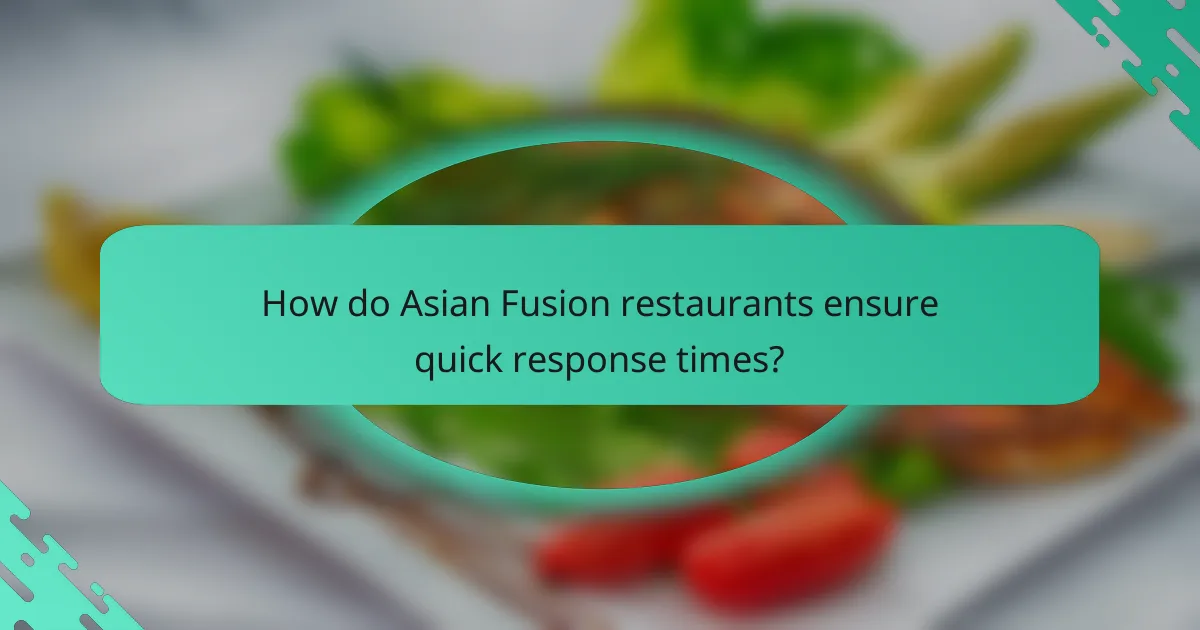Asian Fusion restaurants offer a delightful blend of diverse culinary traditions, merging traditional Asian flavors with global influences to create innovative and unique dishes. In cities like Los Angeles, these establishments are celebrated for their creative menus, which feature everything from inventive sushi rolls to distinctive noodle dishes, appealing to a wide range of palates. Exploring these dining experiences allows food lovers to enjoy a harmonious balance of taste, texture, and presentation.

Where can I find the best Asian Fusion restaurants in Los Angeles?
Los Angeles boasts a vibrant selection of Asian Fusion restaurants that blend diverse culinary traditions. To find the best options, consider reviews, chef credentials, and unique menu offerings that showcase innovative flavor combinations.
Top-rated Asian Fusion restaurants
Some of the top-rated Asian Fusion restaurants in Los Angeles include Koi, known for its sushi and modern Japanese dishes, and Nobu, which offers a high-end take on Japanese-Peruvian cuisine. Another standout is the popular restaurant, Mastro’s, which combines Asian flavors with classic steakhouse elements.
For a more casual experience, check out the food truck scene, where vendors like Kogi BBQ serve Korean tacos that have gained a loyal following. These establishments often receive high marks for creativity and quality, making them must-visit spots.
Neighborhoods with popular options
West Hollywood is a hotspot for Asian Fusion dining, featuring a variety of restaurants that cater to diverse tastes. Here, you can find trendy spots like Tao, which combines Chinese and Asian-inspired dishes in a lively atmosphere.
Downtown Los Angeles also offers a rich selection, with restaurants like The Bazaar by José Andrés, where traditional Spanish flavors meet Asian influences. Additionally, the San Gabriel Valley is renowned for its authentic Asian cuisine, including fusion concepts that attract food enthusiasts from all over the city.

What unique flavors define Asian Fusion cuisine?
Asian Fusion cuisine is characterized by the blending of diverse Asian culinary traditions with elements from other global cuisines, creating innovative and unique flavor profiles. This approach often results in dishes that showcase a harmonious balance of taste, texture, and presentation, appealing to a wide range of palates.
Combination of Asian culinary traditions
Asian Fusion cuisine draws from a variety of culinary traditions, including Chinese, Japanese, Thai, and Indian, among others. Chefs often experiment by combining techniques and ingredients from these cultures, resulting in dishes that are both familiar and novel. For instance, a sushi roll might incorporate elements of Mexican cuisine, such as avocado and spicy salsa, creating a unique dining experience.
When exploring Asian Fusion, consider how different cooking methods, like stir-frying or steaming, can be integrated with non-Asian techniques, such as grilling or roasting. This fusion not only enhances flavors but also introduces new textures, making the dining experience more dynamic.
Signature ingredients and spices
Key ingredients in Asian Fusion cuisine often include a mix of traditional Asian staples like soy sauce, ginger, and lemongrass, alongside non-Asian elements such as cheese or barbecue sauces. This combination allows for creative reinterpretations of classic dishes. For example, a Thai green curry might be paired with Italian pasta, offering a delightful twist on both cuisines.
Spices play a crucial role in defining the flavors of Asian Fusion dishes. Commonly used spices include five-spice powder, curry powder, and chili paste, which can be blended with herbs like basil and cilantro. When experimenting with flavors, it’s essential to balance the intensity of these spices to avoid overpowering the dish while still achieving a memorable taste.

What creative dishes are popular in Asian Fusion restaurants?
Asian Fusion restaurants are known for their inventive dishes that blend traditional Asian flavors with modern culinary techniques. Popular creative dishes often include unique sushi rolls, innovative noodle dishes, and distinctive appetizers that showcase a variety of cultural influences.
Signature sushi rolls
Signature sushi rolls are a hallmark of Asian Fusion cuisine, combining classic sushi elements with unexpected ingredients. For example, a spicy tuna roll may be enhanced with avocado and a drizzle of wasabi mayo, creating a rich flavor profile. Diners can expect a range of options, from tempura shrimp rolls to those featuring tropical fruits like mango.
When exploring sushi rolls, consider the balance of flavors and textures. A good roll should have a harmonious mix of fresh fish, crunchy vegetables, and creamy sauces. Look for restaurants that offer a selection of specialty rolls to experience the creativity of their chefs.
Innovative noodle dishes
Innovative noodle dishes in Asian Fusion restaurants often reinterpret traditional recipes, incorporating diverse ingredients and cooking styles. Dishes like Pad Thai with a twist, featuring grilled chicken and a peanut sauce, or ramen topped with kimchi and a soft-boiled egg, highlight this creativity. These combinations not only enhance flavor but also provide a unique dining experience.
When choosing noodle dishes, pay attention to the sauce and toppings, as they can significantly alter the dish’s overall taste. Many restaurants offer customizable options, allowing you to select your preferred protein and spice level, making it easy to tailor your meal to your liking.
Unique appetizers
Unique appetizers set the tone for the dining experience in Asian Fusion restaurants, often featuring a mix of flavors and textures. Popular choices include Korean BBQ meatballs, edamame hummus served with rice crackers, or crispy spring rolls filled with unconventional ingredients like duck or quinoa. These starters are designed to intrigue and excite the palate.
When ordering appetizers, consider sharing a variety to sample different flavors. Many Asian Fusion restaurants offer tasting platters that allow you to experience multiple dishes in one go. This approach not only enhances your meal but also encourages a communal dining atmosphere.

How do Asian Fusion restaurants create memorable dining experiences?
Asian Fusion restaurants create memorable dining experiences by blending diverse culinary traditions and innovative presentation styles. This approach not only tantalizes the taste buds but also engages diners through unique atmospheres and interactive elements.
Ambiance and decor
The ambiance and decor of Asian Fusion restaurants play a crucial role in enhancing the dining experience. Many establishments incorporate elements from various Asian cultures, such as traditional art, lighting, and furniture, to create an inviting atmosphere. For instance, a restaurant might feature bamboo accents, lanterns, and vibrant colors to evoke a sense of authenticity.
Attention to detail in decor can significantly impact diners’ perceptions. Soft music, aromatic scents from the kitchen, and comfortable seating arrangements contribute to a relaxed environment, encouraging guests to linger and enjoy their meals. A well-designed space can elevate a simple meal into a memorable occasion.
Interactive dining options
Interactive dining options are a hallmark of many Asian Fusion restaurants, allowing guests to engage with their food in unique ways. Options such as hot pot, where diners cook their ingredients at the table, or sushi-making classes, provide a hands-on experience that enhances enjoyment and connection to the cuisine.
These interactive elements not only entertain but also foster social interaction among diners. Sharing dishes, participating in cooking, or even customizing meals can create a sense of community and make the dining experience more memorable. Consider trying a restaurant that offers these options for a more engaging meal.

What are the pricing bands for Asian Fusion dining?
Asian Fusion dining typically falls within a moderate to high price range, influenced by the restaurant’s location, ambiance, and the complexity of the dishes. Expect to spend anywhere from $15 to $50 per person, depending on whether you are dining casually or at a more upscale establishment.
Average meal costs
The average cost for a meal at an Asian Fusion restaurant can vary significantly. Casual dining spots may charge around $15 to $25 per person, while more upscale venues often range from $30 to $50 or more. This pricing usually includes an appetizer, main course, and possibly a drink.
For those looking for a more budget-friendly option, lunch specials or prix fixe menus can provide a great value, often priced between $10 and $20.
Price ranges for different dishes
When it comes to specific dishes, appetizers typically range from $5 to $15, while main courses can vary from $15 to $35. Specialty items, such as sushi rolls or unique fusion creations, may cost upwards of $20.
For dessert, expect to pay between $6 and $12. Keep an eye out for seasonal specials or chef’s recommendations, which can offer unique flavors at varying price points.

What permits are required for operating an Asian Fusion restaurant?
Operating an Asian Fusion restaurant typically requires several permits to ensure compliance with local regulations. These permits often include health and safety permits, as well as business licenses, which are essential for legal operation and maintaining food safety standards.
Health and safety permits
Health and safety permits are crucial for any restaurant, including Asian Fusion establishments. These permits ensure that the restaurant meets local health codes, which cover food handling, sanitation, and employee hygiene. Depending on the location, the process may involve inspections by health department officials.
Common requirements for health permits include food safety training for staff, regular inspections, and adherence to specific food storage and preparation guidelines. It’s advisable to consult local health regulations to understand the exact requirements and avoid potential fines or closures.
Business licenses
Business licenses are mandatory for operating an Asian Fusion restaurant and vary by city or state. These licenses grant legal permission to run a business and may include specific permits for food service. Typically, the application process involves submitting documentation about the business structure, ownership, and location.
When applying for a business license, ensure that all necessary paperwork is complete and accurate. Some jurisdictions may require additional permits, such as a liquor license if alcohol is served. Always check with local authorities for the most current licensing requirements to prevent delays in opening your restaurant.

How do Asian Fusion restaurants ensure quick response times?
Asian Fusion restaurants prioritize quick response times by implementing efficient service models and rigorous staff training. These strategies help streamline operations, ensuring that customers receive their orders promptly while enjoying a diverse culinary experience.
Efficient service models
To enhance response times, many Asian Fusion restaurants adopt efficient service models such as open kitchens and streamlined menus. Open kitchens allow for better communication between chefs and servers, reducing delays in order processing. Additionally, a focused menu with signature dishes can minimize preparation time, enabling faster service.
Some establishments utilize technology, like table-side ordering systems or mobile apps, to expedite the ordering process. This not only speeds up service but also reduces the chances of errors, ensuring that customers receive exactly what they ordered.
Staff training protocols
Comprehensive staff training is crucial for maintaining quick response times in Asian Fusion restaurants. Employees are trained to understand the menu thoroughly, allowing them to make recommendations and answer questions efficiently. This knowledge empowers staff to serve customers more effectively, enhancing the overall dining experience.
Regular training sessions also focus on improving teamwork and communication among staff members. By fostering a collaborative environment, restaurants can ensure that orders are processed swiftly and accurately, minimizing wait times for diners.

What are the criteria for selecting an Asian Fusion restaurant?
When selecting an Asian Fusion restaurant, consider the quality of ingredients, the creativity of the menu, and the authenticity of the dishes. Look for establishments that balance traditional Asian flavors with innovative culinary techniques, ensuring a unique dining experience.
Customer reviews and ratings
Customer reviews and ratings are essential when evaluating an Asian Fusion restaurant. They provide insights into the dining experience, including food quality, service, and ambiance. Websites like Yelp or TripAdvisor can help gauge overall satisfaction and highlight popular dishes.
Pay attention to both the quantity and quality of reviews. A restaurant with a high number of positive reviews is often a good sign, while a few negative comments can indicate specific issues. Look for patterns in feedback, such as consistent praise for certain dishes or complaints about service delays.
Consider the context of the reviews as well. A restaurant may receive lower ratings during peak hours due to high demand. Checking recent reviews can offer a clearer picture of the current dining experience, especially if the restaurant has made recent changes to its menu or staff.

